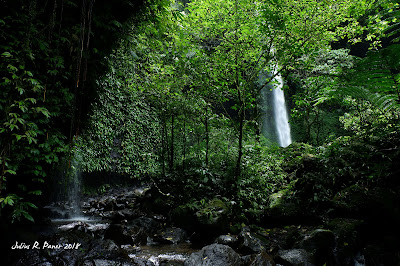It took me more than a
week to write an article about my day trek in Tomari Waterfalls last May 17
because of several workloads which included a 2-day climb in Mt. Apo, among
other things. This waterfalls, which have been in the list of explorable destinations,
is an additional thing that substantiates our very own “Spectacular Sta. Cruz”
tag line.
At a secluded location 32
kilometers northwest of Sta. Cruz lies majestic waterfalls settled some 400
plus meters above sea level. Locals call it Secret Falls, but we used to call
it Tomari Waterfalls because it is where the Tomari creek springs out as a major
tributary of the Sibulan River. It has a height of approximately 50 meters dropping
to a 15-meter diameter pool of cold and crystal clear water.
The nearest jump off
point is at sitio Cabarisan in Sibulan, Sta. Cruz. A moderate 40-minute trek is
required to reach the falls via an open trail to Cabarisan HEDCOR Desander, and
then another 20 minutes river trekking. The
waterfalls define the accurate border of three sitios in Sibulan namely:
Mitondo, Mamaon and Cabarisan. Since the road going to Cabarisan from Sibulan
Barangay Hall is not passable by 4-wheeled vehicles, we took a 360 degrees turn
using the much easier road of Atan-awe and Sibulan City side in order to reach
the jump off point.
Our trekking along the
Tomari Creek also offered a distinct experience being brought by the pristine
water from the creek. In fact, almost all parts of the creek water are potable. Complementing
Tomari Waterfalls from the other side is a cute waterfalls which also entices
river trekkers as it is a welcoming site to also behold.
It is very evident that
Cabarisan is still decorated with huge tree species, some I think are natural
forest while others are result of reforestation efforts conducted by HEDCOR,
the place being part of their project area. While approaching Mt. Apo
Elementary School I saw one Rufous-lored Kingfisher and as we near Tomari
waterfalls I spotted a solitary Pied Triller. Indeed, the mountain ranges of north-western
Sta. Cruz is home to several bird species.
What is more
interesting about Tomari Waterfalls is its semblance to the now-defunct Tudaya
Waterfalls. Aside from being located just distance away from sitio Tudaya,
Tomari Waterfalls for me stood out as an attraction that somehow could transport
us back to the magnificence of Tudaya Falls. It might not present the whole
grandeur of Tudaya Falls but it resembles in certain ways.For those who are unfortunate to have not witnessed Tudaya Falls in all its glory, I recommend you try trekking Tomari Waterfalls.
With the untimely termination
of Tudaya Falls as one of the collateral damages of the so-called development,
there is this Tomari Waterfalls ready to be another appealing destination in
Sta. Cruz. Its emergence lately manifests new courage for us to struggle for
its protection. With Tomari Waterfalls now bent on providing another positive
perspective for our beloved hometown, I hope that the people of Sta. Cruz have
fully realized and awakened of the adverse impact of the thing they called development.



































